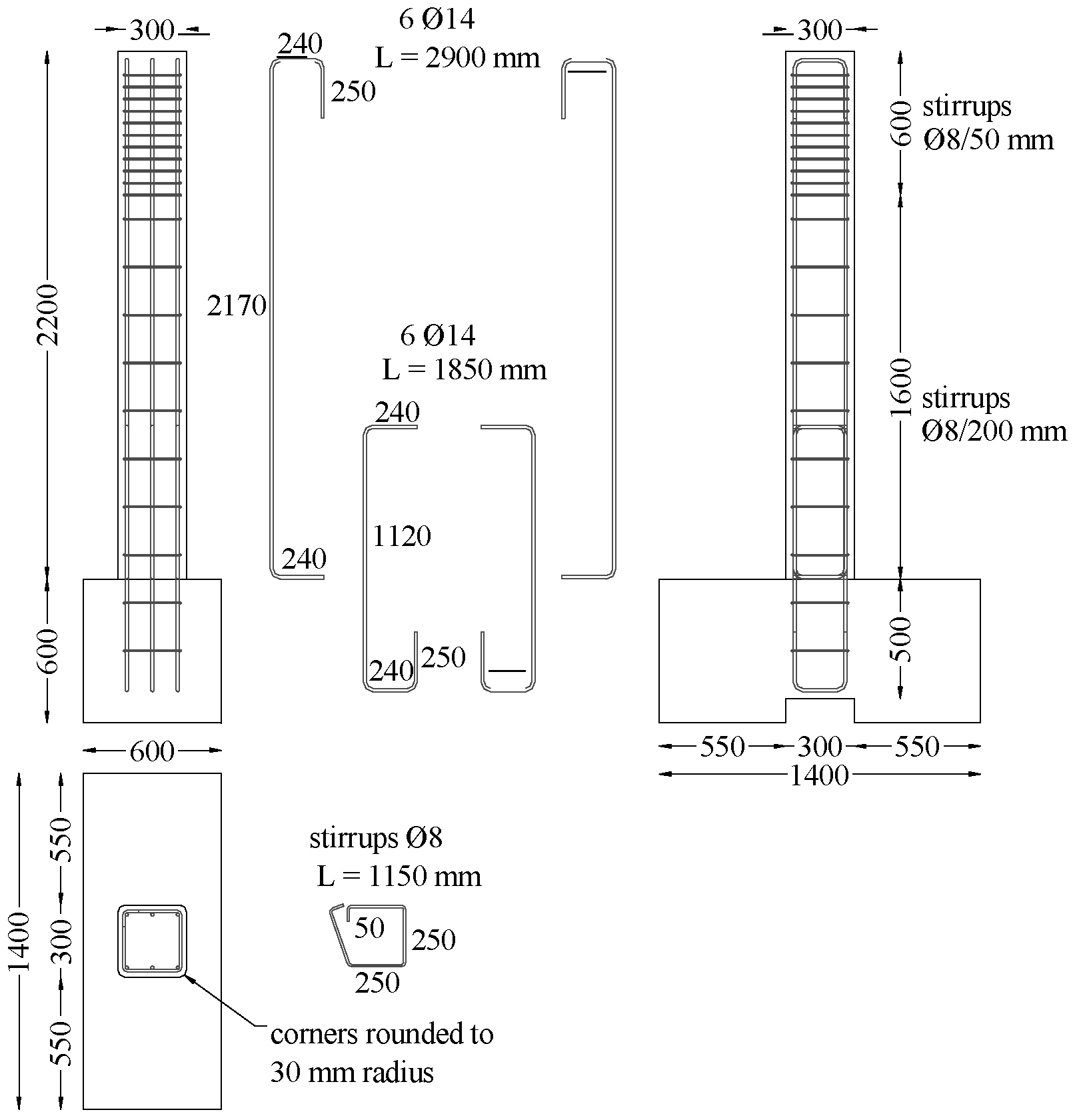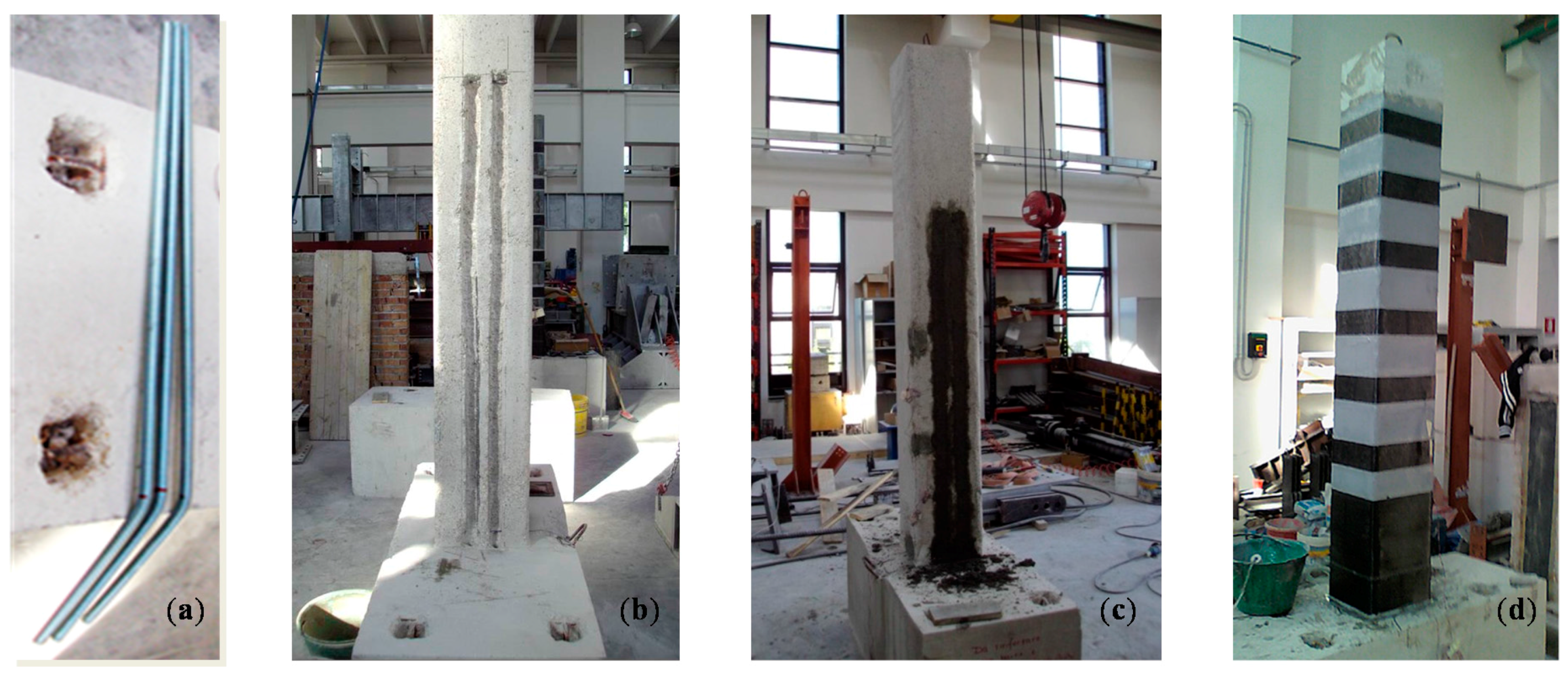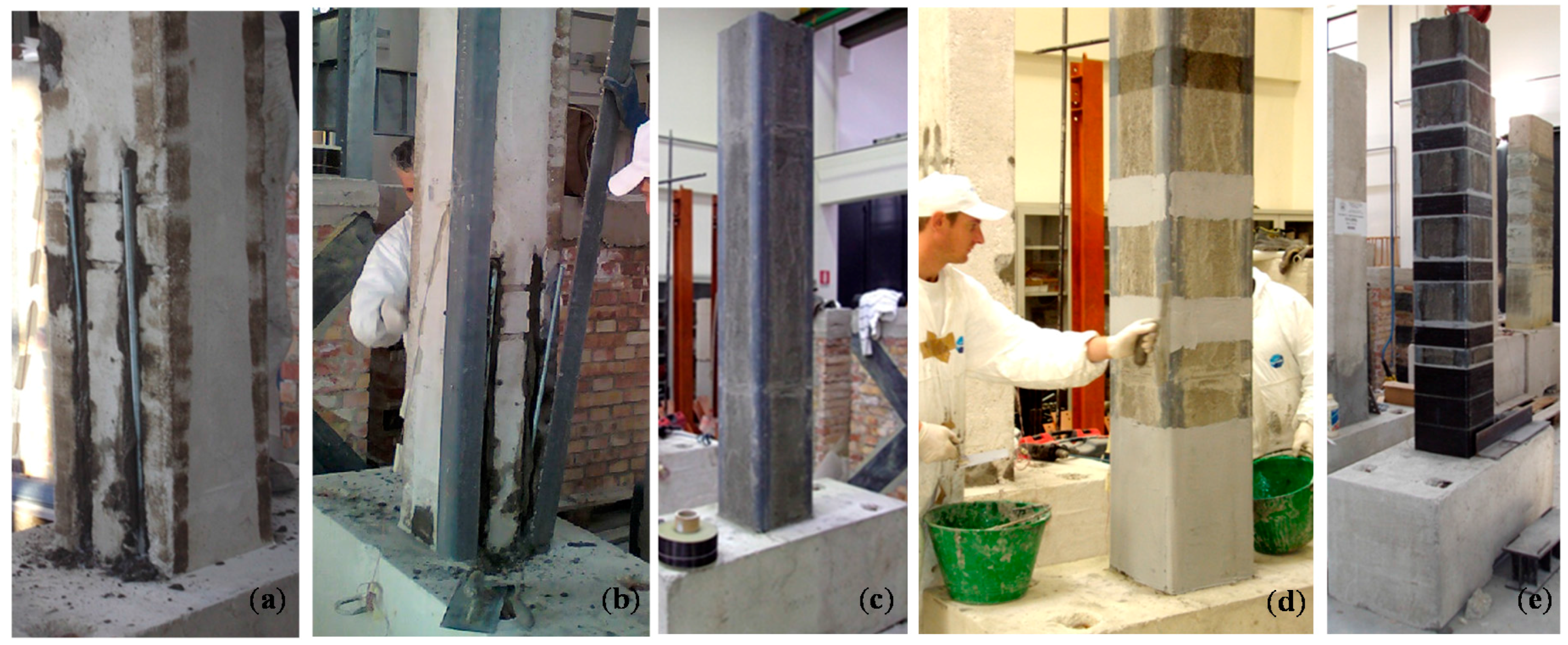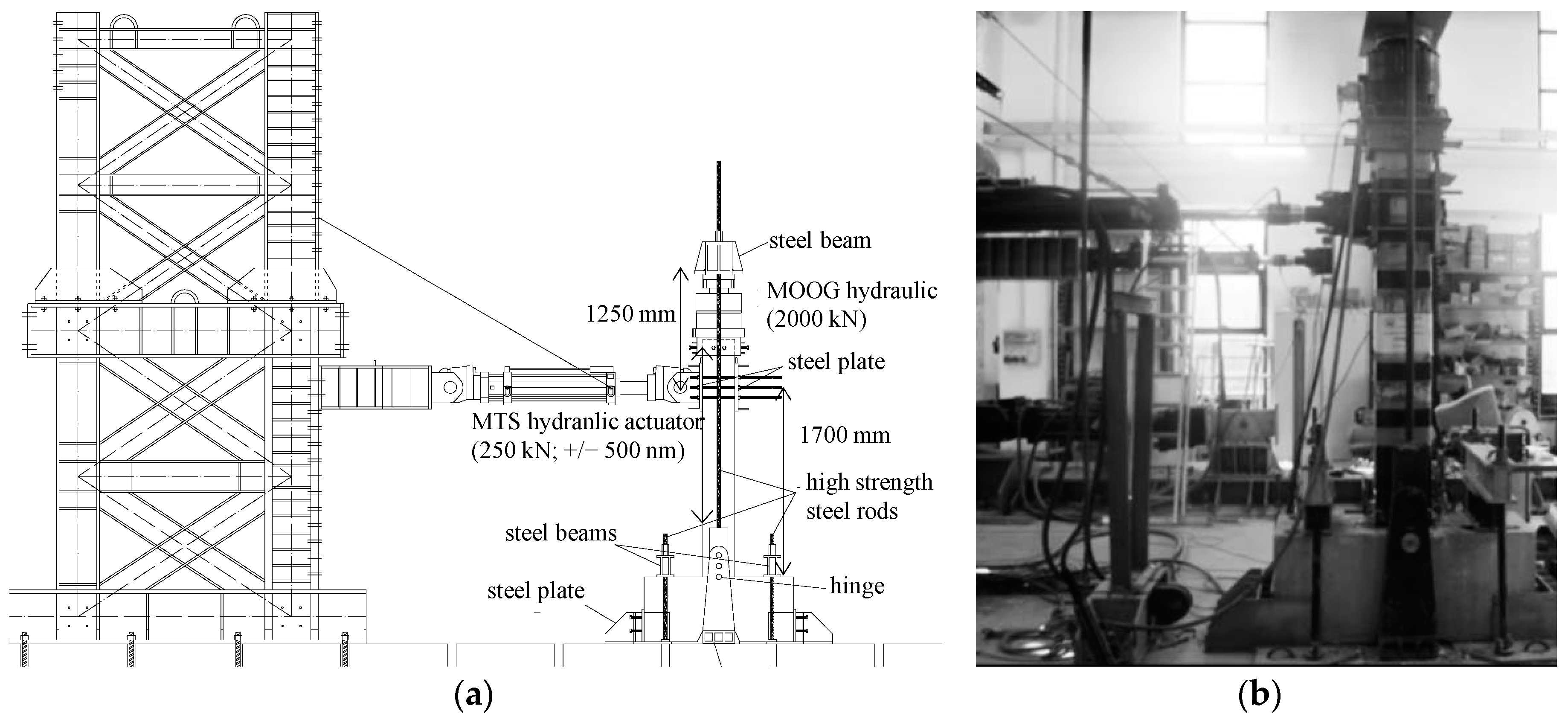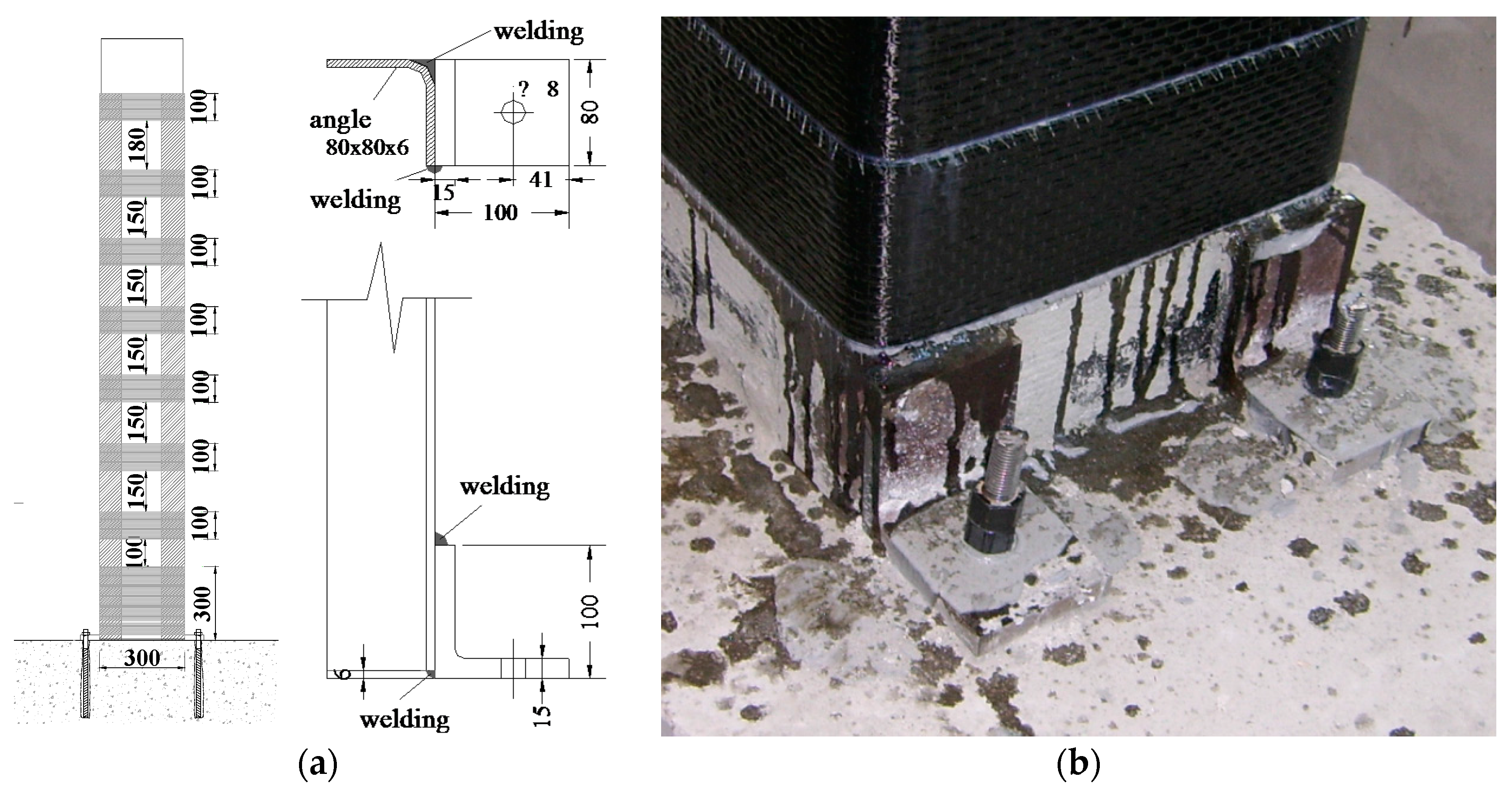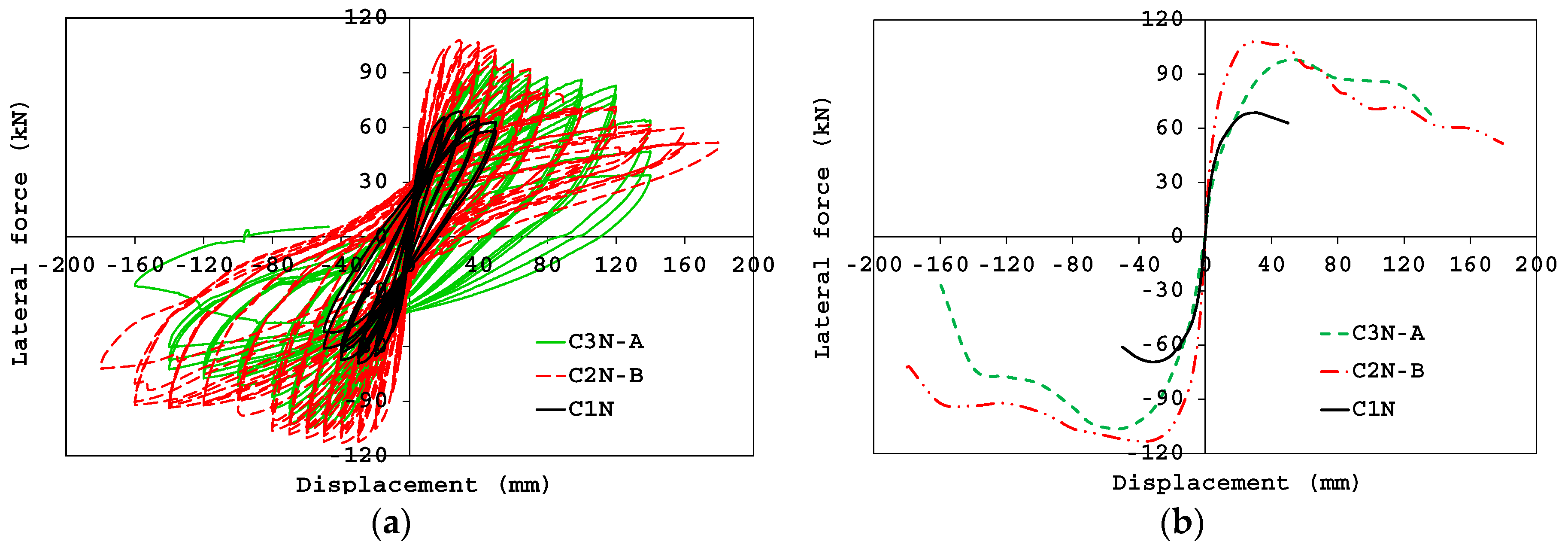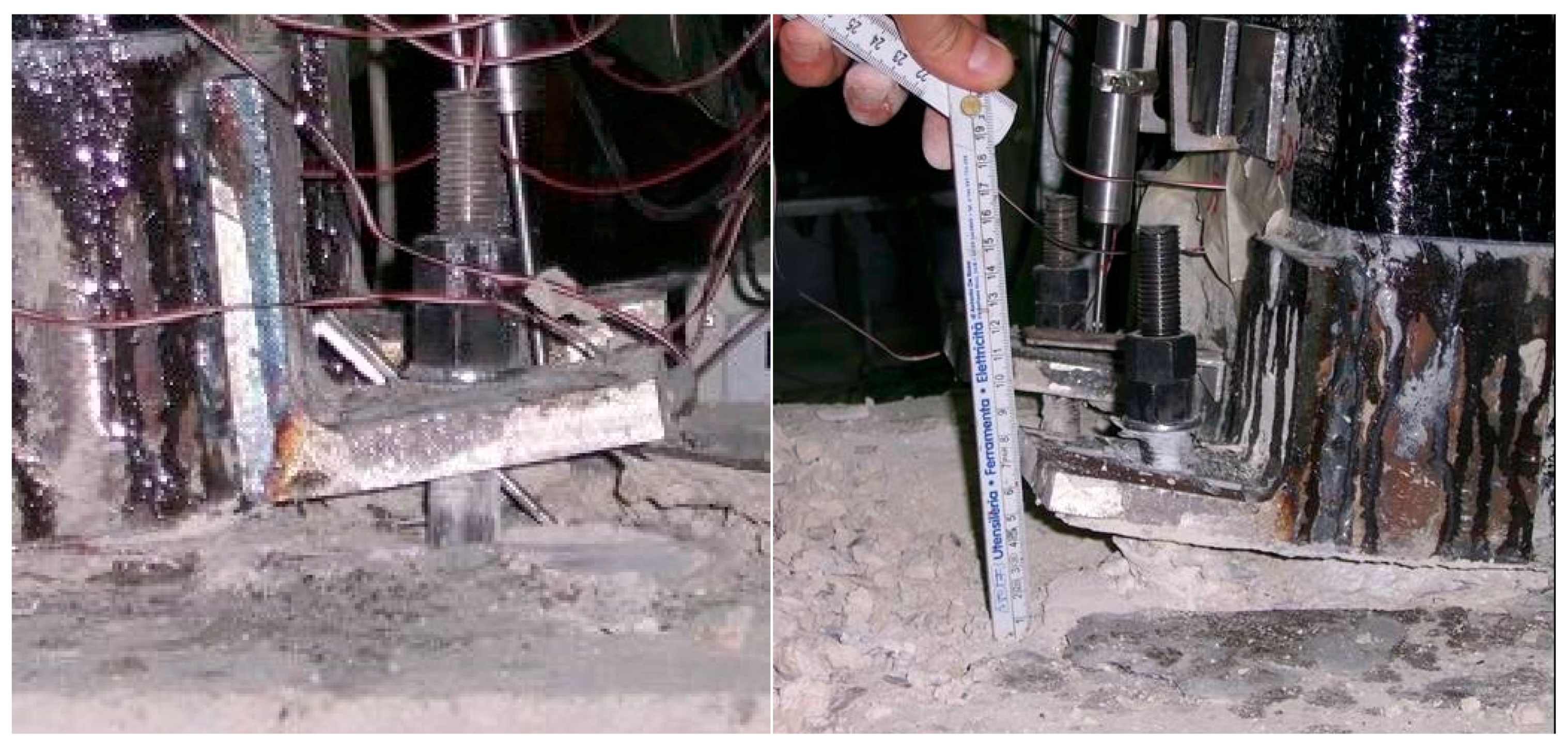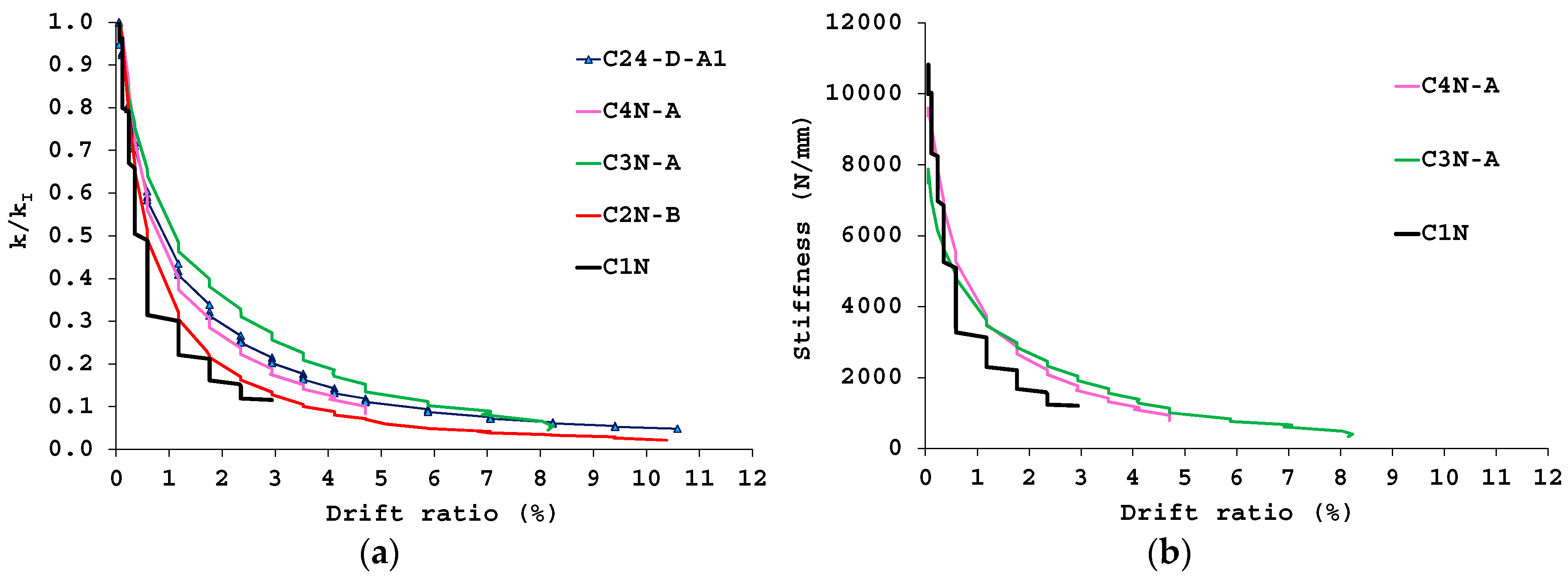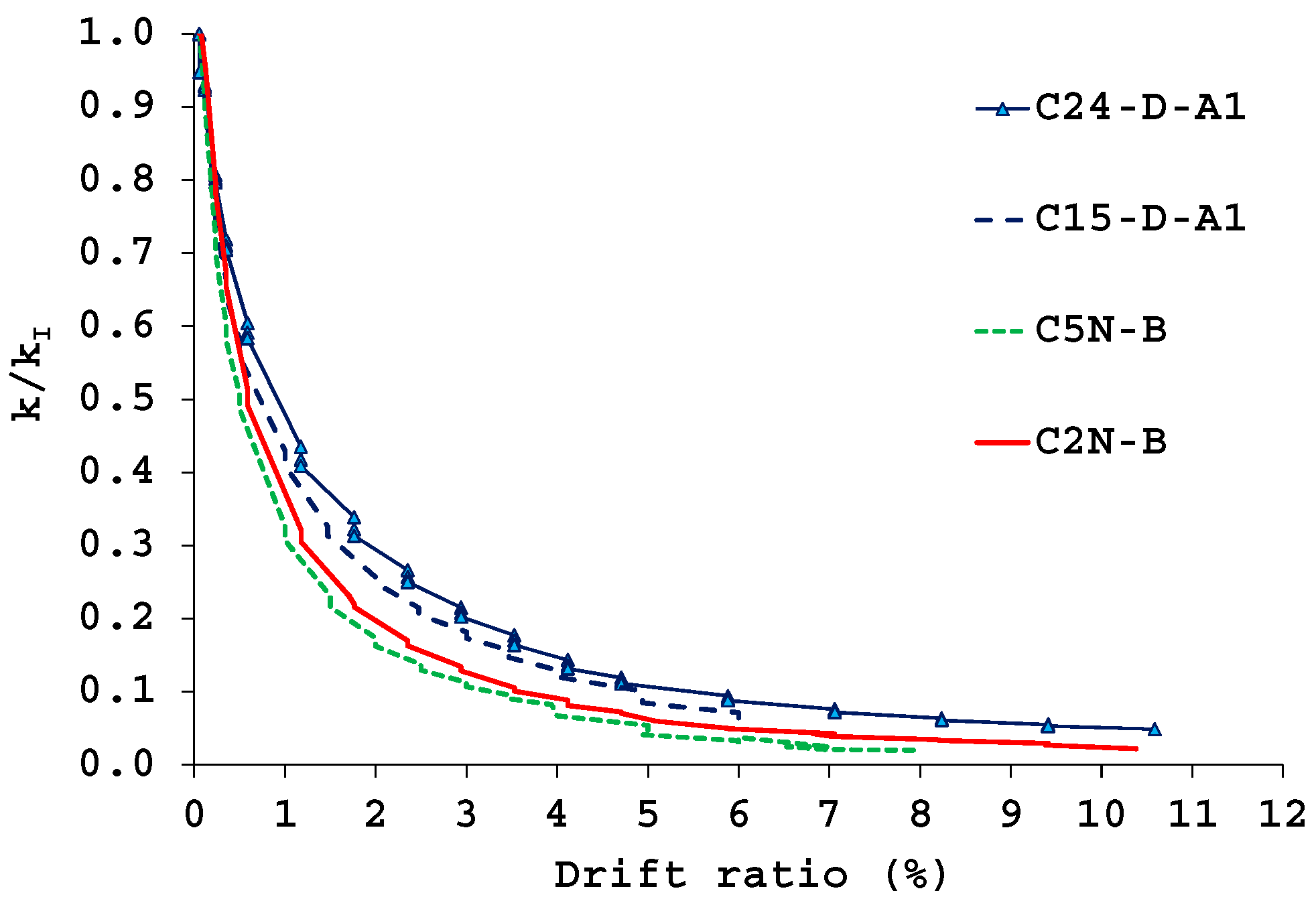Each test is identified by a label providing the following information: the column number (from C1 to C5) with the addition of “N” (
i.e., “new”) to distinguish these tests from those of the previous experimental campaign [
12]; the strengthening system (type ‘‘A’’ or ‘‘B’’ in
Figure 2a,b, respectively). It is noted that the test C1Nr-A refers to the control specimen C1N that, after being tested, was repaired and FRP retrofitted according to the layout “type A”. The repairing procedure consisted of: (a) removing the damaged concrete surface in the first portion of the column (≈200 mm), where a slight phenomenon of rebars’ buckling was observed at the end of the test C1N; (b) cleaning and filling the missing concrete with proper fiber reinforced mortar, and (c) subsequently applying the FRP system “type A”.
In addition to information about the FRP strengthening layout and the number of FRP layers employed for the continuous wrapping of the column,
Table 1 reports: the actual value of
fcm estimated per each column by testing in compression a set of three 150 mm edge cubic samples; the normalized value of ν and the corresponding applied axial load
N; the peak lateral strengths in the two directions of loading (
F+max and
F−max), the corresponding displacements (Δ
+ and Δ
−) and the maximum displacements of the column (Δ
+85% and Δ
−85%) measured at the conventional collapse.
With the aim to better compare the effectiveness of the considered strengthening techniques,
Table 1 also reports data and results of three tests performed in the previous experimental campaign, namely C9-D, C15-D-A1 and C24-D-A1 [
12], for which the maximum displacements reported herein were computed at 85% conventional collapse (not available for the test C9-D). These specimens had the same geometry and steel reinforcement configurations of those used for the new test members. Except for the specimen C9-D, that was unstrengthened and used herein as control specimen for the only test performed under ν = 0.14 (
i.e., test C5N-B), the other members were strengthened using a system “type A1” (see
Figure 6a,b). As mentioned earlier, such a system is characterized by the combined use of CFRP confinement and steel profiles placed at the column’s corners and connected to the foundation by using an L-shape steel system. The layout of FRP confinement and the arrangement of steel profiles are the same of those in
Figure 2b, whereas details on the anchorage system of such profiles, illustrated in
Figure 6b, can be found in [
12].
Figure 6.
Strengthening systems “type A1” (a); details of steel profile’s anchorage system (b).
It is worth noting that, as it can be observed in
Table 1, the compressive strengths of concretes used for manufacturing the specimens C15-D-A1 and C24-D-A1 are rather comparable to those of the “new” test specimens; conversely, the specimen C9-D is characterized by an
fcm value significantly greater than the other concrete strengths thus affecting a direct comparison with the test C5N-B. In addition, it is highlighted that a value of ν slightly lower than 0.14 (ν = 0.13) was used for the test C9-D, due to technical issues of the testing machine.
The following sections better detail the discussion of the test results.
3.1. Cyclic Curves
Figure 7 and
Figure 8 show the lateral force (
F)–displacement (Δ) hysteretic curves and the corresponding
F–Δ envelopes for some tested specimens. In particular, in
Figure 7a the cyclic response of the control specimen (C1N) is compared with the performance of two members strengthened with the FRP systems “type B” and “type A” (samples C2N-B and C3N-A, respectively).
Figure 7.
F–Δ hysteresis curves (a) and envelopes (b): columns C1N, C2N-B and C3N-A.
Figure 7.
F–Δ hysteresis curves (a) and envelopes (b): columns C1N, C2N-B and C3N-A.
Figure 8.
F‒Δ hysteresis curves (a) and envelopes (b): columns C1N, C3N-A and C4N-A.
Figure 8.
F‒Δ hysteresis curves (a) and envelopes (b): columns C1N, C3N-A and C4N-A.
As expected, the reference column experienced a rapid degrading behavior in the post-peak phase and achieved the collapse under low values of the imposed displacement. Disregarding the type of strengthening system, the specimens C2N-B and C3N-A have exhibited significant increases of strength over the control specimen (about 60% and 48%, respectively). The improvement of the column’s confinement through the use of steel profiles avoided the rupture of the FRP wrapping and delayed the crushing of concrete; indeed, after achieving the conventional collapse, the sample C2N-B showed a less degrading behavior with respect to the sample C3N-A and was capable of still undergoing significant lateral displacements. It is highlighted that the failure of two additional steel rods (on the same column’s side), due to a slight slippage combined to a fatigue phenomenon, was observed for the specimen C2N-B at imposed displacements of 90 and 120 mm (corresponding to lateral loads in the post-peak phase equal to about 78 and 70 kN, respectively.
Figure 8a,b shows the dependence of the cyclic response on the number of FRP layers employed for the continuous wrapping at column base; the
F–Δ comparisons clearly highlight the beneficial role of using a double layer of CFRP layers in improving the deformation capacity of specimens. In particular, it is observed that the lateral displacement exhibited by the specimen C3N-A at the conventional collapse is about 30% over that measured for the counterpart confined with a single FRP layer; an increase of flexural strength equal to about 15% is also computed.
Figure 9a shows the
F–Δ monotonic envelopes of test specimens subjected to ν = 0.40 which are also compared with the curve of the column C24-D-A1 [
12]. Furthermore, in order to by-pass the dependence of the response on the concrete strength value, in
Figure 9b the experimental results have been represented in terms of normalized flexural strength–drift ratio (μ–δ) curves. μ and δ are given by:
where
B and
H are the width and depth of the column cross section, respectively;
F is the horizontal force applied by the actuator and Δ the corresponding displacement;
Ls (=1700 mm) is the column’s shear span.
Figure 9.
F‒Δ envelopes (a) and μ‒δ envelopes (b) under ν = 0.40.
Figure 9.
F‒Δ envelopes (a) and μ‒δ envelopes (b) under ν = 0.40.
From the experimental
F–Δ comparisons it is noted that the strengthening system “type A1” provides increases of flexural strength and ductility slightly greater than those obtained through the layout “type B”; conversely, as mentioned earlier, this beneficial effect is offset by the need of time consuming and labor-intensive operations to provide a proper installation of the anchor system of steel profiles; on site, such installation is even more difficult when the anchoring of column’s steel profiles is made into a beam member rather than a concrete foundation. In addition, the strength increase progressively reduces with the occurrence of the slipping of the steel connector linking the profile’s anchor system to the concrete foundation, as shown in
Figure 10 [
12]; therefore, the performance provided by the use of a system “type A1” strongly depends on the proper design of the steel profile’s anchoring to the concrete beam/foundation.
Figure 10.
Pull-out of the steel connector from the concrete foundation.
Figure 10.
Pull-out of the steel connector from the concrete foundation.
Figure 11 allows for investigating the influence of the axial load level ν on the experimental response of specimens strengthened with the system “type B”. For this purpose,
Figure 11a shows the comparison between the
F–Δ cyclic curve of column C2N-B and that of the specimen C5N-B, subjected to ν equal to 0.40 and 0.14, respectively;
Figure 11b, instead, depicts the corresponding
F‒Δ envelopes, with the addition of the curve related to the reference specimen C1N, available for ν = 0.40.
As expected, the presence of a higher axial load approximately produces a 37% strength increase, thus confirming the beneficial effect of the CFRP confinement for significant values of the acting axial load.
Figure 11.
F‒Δ hysteresis curves (a) and envelopes (b): columns C2N-B (ν = 0.40) and C5N-B (ν = 0.14).
Figure 11.
F‒Δ hysteresis curves (a) and envelopes (b): columns C2N-B (ν = 0.40) and C5N-B (ν = 0.14).
Furthermore, to better examine the performance of the specimen C5N-B subjected to a low value of the axial load, in
Figure 12a,b the cyclic response and the corresponding envelope curve are compared with those of the control (unstrengthened) member C9-D and the strengthened column C15-D-A1, tested in the previous experimental campaign [
12]. It is worth highlighting that, for a better comparison of the experimental behaviors, both graphs have been represented in normalized terms μ‒δ.
Figure 12.
Normalized cyclic (a) and envelope (b) F‒δ curves for specimens subjected to ν = 0.14.
Figure 12.
Normalized cyclic (a) and envelope (b) F‒δ curves for specimens subjected to ν = 0.14.
The plots allow for verifying the beneficial effects of the studied strengthening technique even in presence of low axial load. On average, the flexural strength of the sample C5N-B is about twice that characterizing the control member and only 10% lower than the strength shown by the counterpart C15-D-A1. However, the specimen C5N-B exhibited an abrupt strength degradation in the post-peak phase caused by the rupture of the additional rods arranged in the column, first of which occurred at a displacement of about 70 mm.
Finally, in
Figure 13, the performance of the unstrengthened specimen C1N is compared with that of the repaired one C1Nr-A. The plots allow for verifying the effectiveness of the system “type A” as a repairing technique of damaged columns; as shown, indeed, the application of this system is not only capable of restoring the performance of the original specimen, but also of improving the experimental response in terms of both flexural strength and deformation capacity. By looking at the plot in
Figure 13b, it is observed that, except for the reduced initial stiffness (as shown in the
F‒Δ enlargement), the member C1Nr-A exhibited an increase of strength and ductility over the counterpart C1N of about 43% and 84%, respectively.
Figure 13.
F‒Δ hysteresis curves (a) and envelopes (b): columns C1N and C1Nr-A.
Figure 13.
F‒Δ hysteresis curves (a) and envelopes (b): columns C1N and C1Nr-A.
3.2. Failure Mode
Figure 14,
Figure 15 and
Figure 16 show the crack pattern and failure mode exhibited by test specimens. In particular, as already observed in the previous experimental campaign [
12], the unstrengthened member C1N experienced cracking phenomena and significant damages concentrated in the first 500 mm from the column base (
Figure 14). A flexural crack first developed at the column-foundation interface at a displacement value of 20 mm; the width of this crack did not significantly increase during the test since the specimen rapidly achieved the collapse. Other flexural cracks evenly distributed along the member at a distance of about 200 mm, which approximately corresponds to the stirrups spacing (
Figure 14a). Lacking adequate confinement, the specimen was rapidly involved by the development of vertical cracks due to the incipient buckling of steel rebars (
Figure 14b). Relevant signs of damage and concrete spalling occurred in the first 200 mm from the column base at an imposed displacement of 40 mm (
Figure 14c); the test was stopped soon to avoid severe damage of the member since it had to be repaired and re-tested.
Figure 14.
Crack pattern: control specimen C1N.
Figure 14.
Crack pattern: control specimen C1N.
Disregarding the type of strengthening system, the presence of a FRP jacket has contributed to: inhibit the crack opening; delay the buckling of longitudinal rebars.
Figure 15a,b illustrate the damage exhibited by strengthened specimens C4N-A, C3N-A and C1Nr-A. As expected, the use of a single FRP layer for the external confinement (test C4N-A) strongly penalized the performance of the column since a first rupture of the sheet prematurely occurred in the first 100 mm from the base (see
Figure 15a taken at a displacement of 50 mm). After the FRP system failure, the column rapidly achieved the collapse with the buckling of steel rebars and of the additional rods, stirrups opening and crushing of concrete (
Figure 15b). The cyclic behavior of the strengthened specimen significantly improved by doubling the number of FRP layers (test C3N-A); in this case, the FRP rupture occurred in the first 50 mm from the column base only at a displacement value of 120 mm.
Figure 15c shows the status of damage at the column base at the end of the test: fracture and buckling of some rebars and rods and stirrups opening were observed.
Figure 15.
Damage of specimens strengthened with the system “type A”.
Figure 15.
Damage of specimens strengthened with the system “type A”.
The presence of longitudinal steel profiles (system “type B”) has further inhibited the damage and crack propagation. Independently on the applied axial load ν (0.14 or 0.40) the arrangement of steel profiles avoided the FRP rupture at the base even for high values of the imposed displacement, as shown in
Figure 16a. Approaching the end of the test, the FRP exhibited only a bulging in the first 50 mm from the base, whereas inside the wrap the concrete column was severely damaged (
Figure 16b). Specimens C5N-B and C2N-B have both experienced the rupture of additional steel rods at column-foundation interface.
Figure 16.
Damage of specimens strengthened with the system “type B”.
Figure 16.
Damage of specimens strengthened with the system “type B”.
3.3. Stiffness Degradation and Energy Dissipation
Based on the experimental results, it was possible to evaluate the mean value of stiffness for the
i-th cycle by using the following ratio [
17]:
where
and
denote the maximum values of the lateral force at the
i-th cycle in the push and pull directions, and
and
are the corresponding displacements.
By normalizing the stiffness of each displacement cycle k with respect to that of the first cycle kI, it was possible to obtain a measure of the stiffness degradation.
Figure 17a depicts the relationship between the normalized stiffness
k/k
I and the drift ratio for all the specimens subjected to the higher axial load (ν = 0.40). As expected, lacking the external confinement, the unstrengthened column C1N experienced a more rapid strength degradation with respect to the other specimens. Conversely, it seems that the column C3N-A, although not provided with longitudinal steel profiles, exhibited a strength degradation lower than the counterparts C2N-B and C24-D-A1. This result can be motivated by observing
Figure 17b showing that the specimen C3N-A was characterized by an initial stiffness already reduced and significantly lower than that of the control specimen C1N; this evidence might have affected the corresponding strength degradation making it lower than the effective one. However, from
Figure 17b it can be observed that also the column C4N-A showed an initial stiffness lower than the unstrengthened specimen. For both columns C3N-A and C4N-A, this reduced initial stiffness can be partly motivated in the installation procedure of the system “type A” which, by requiring the cutting of concrete grooves for introducing the additional steel rods, inevitably induces a pre-damage of the specimens; probably, this pre-damage is not relevant in the case of the specimen C2N-B where the presence of steel angles in some way does not affect the initial stiffness.
Figure 17.
Stiffness degradation (a) and stiffness-drift ratio relationship (b) specimens subjected to ν = 0.40.
Figure 17.
Stiffness degradation (a) and stiffness-drift ratio relationship (b) specimens subjected to ν = 0.40.
In
Figure 18 the stiffness degradation of columns strengthened with the system: “type B” is compared with that exhibited by the counterparts previously strengthened with the alternative system employing steel profiles at the columns corners (
i.e., systems “type A1”). As shown, regardless of the axial load level, the specimens C15-D-A1 (ν = 0.14) and C24-D-A1 (ν = 0.40) exhibited a lower stiffness degradation with respect to the corresponding members C5N-B (ν = 0.14) and C2N-B (ν = 0.40); this result implies that the introduction of internal steel rods in addition to steel profiles and CFRP confinement was less effective than the use of a more complex system like the type A1 one.
Finally,
Figure 19 depicts the relationships between the cumulative dissipated energy (
E) and the imposed drift ratio. This energy parameter was calculated from the area under the lateral load-displacement response enclosed within one complete cycle up to the achievement of the conventional collapse for each specimen. In particular, the plot in
Figure 19a refers to all the specimens subjected to the higher axial load (ν = 0.40), whereas that in
Figure 19b allows for a comparison between systems “type B” and “type A1”.
Figure 18.
Stiffness degradation: specimens strengthened with the systems “type B” and “type A1”.
Figure 18.
Stiffness degradation: specimens strengthened with the systems “type B” and “type A1”.
Figure 19.
Energy dissipation: specimens subjected to ν = 0.40 (a) and comparison between systems “type B” and “type A1” (b).
Figure 19.
Energy dissipation: specimens subjected to ν = 0.40 (a) and comparison between systems “type B” and “type A1” (b).
As already highlighted in [
12], from
Figure 19a it is observed that the CFRP system produces a significant increase of the cumulative dissipated energy; however, in comparison with the unconfined member C1N, there is no remarkable improvement of the dissipated energy at a given displacement cycle (except for the specimen C2N-B). In the case of the strengthening system “type A”, it is noted that doubling the number of the FRP layers (from one to two) produced only a small increase of the energy performance (compare test C4N-A and C3N-A). Furthermore, disregarding the presence of steel profiles at column corners, the plot in
Figure 19a shows that, in terms of dissipated energy, the CFRP strengthening systems “type A” and “type B” are more effective than the previous solution “type A1”, whose width of the hysteresis cycles is strongly affected by the performance of steel profile’s anchoring to the concrete beam/foundation. This experimental evidence is also confirmed by observing the plot in
Figure 19b where, regardless of the applied axial load level, the energy dissipated by columns strengthened with the system “type B” is significantly greater than that computed for the counterparts C15-D-A1 and C24-D-A1.
3.4. Strain Values
As already mentioned, measurements of the hoop FRP strain were recorded during tests by eight strain gauges (labelled H1, H2 and H8) arranged on the FRP jacket at a distance of about 100 mm from the column base. In addition, in the case of the strengthening system “type B”, two couples of strain gauges (labelled V1–V2, and V3–V4) were placed on the respective steel L-shape profiles (at about 600 mm from the column base) to monitor the strain distribution during tests.
Figure 20 shows for the strengthened members the envelopes of the FRP transverse strains (ε
h) plotted under both positive (push) and negative (pull) directions of the imposed displacement Δ; such plots allow for obtaining a qualitative trend of the strains achieved by the FRP jacket. In particular, the strain diagrams refer to the maximum values recorded at the first of the three cycles performed at each level of the imposed displacement, up to the end of the test (when the measures were available); negative and positive values of ε
h indicate compressive and tensile strains of the FRP jacket, respectively.
Under Δ = 0, i.e., at the origin of the ε–Δ axes, the plots report the small values of the FRP strains exhibited after the application of pure axial load on the columns.
Observing the plots in
Figure 20, it is highlighted that, disregarding the type of strengthening system, the maximum tensile strains never attained the ultimate FRP strain value indicated by the supplier (ε
f,u = 8‰); in particular, except for measures provided some strain gauges, the higher strains were below the 2‰–2.4‰ threshold (which is only 1/4–1/3 of ε
f,u).
By comparing the plots in
Figure 20a,b it is observed that, at a given level of the imposed displacement, the tensile strains recorded in the case of the test C4N-A were generally higher than those measured by doubling the number of layers for the continuous FRP jacket (test C3N-A), with maximum values recorded by the strain gauge H2.
The FRP strains typically increase in the case of the strengthening system “type B” (see test C2N-B in
Figure 20c), where the values recorded by strain gauges H6 and H8 are well over the 2‰ threshold. Conversely, reduced values were, on average, recorded for the specimen C5N-B (
Figure 20d) where a reduced efficacy of the FRP jacket is obtained under lower axial load levels (ν = 0.14).
Figure 20.
FRP strains: tests C3N-A (a); C4N-A (b); C2N-B (c); and C5N-B (d).
Figure 20.
FRP strains: tests C3N-A (a); C4N-A (b); C2N-B (c); and C5N-B (d).
Finally, by focusing on the strengthening system “type B”,
Figure 21 shows the envelopes of the longitudinal strains (ε
v) recorded by the couples of strain gauges V1, V2 and V3, V4 placed on the L-shape steel profiles (the measures were not always available); negative and positive values of ε
v indicate compressive and tensile strains in the profiles, respectively. A rather symmetric response of the strains in the push and pull directions is observed from the plots, with maximum values recorded under the higher axial load (test C2N-B in
Figure 21a); however, it is highlighted that such strains were always below 0.9‰, thus implying that the use of steel profiles mainly contributes to improving the external confinement of the columns rather than significantly increasing their flexural strength.
Figure 21.
Strains on the L-shape steel profiles: tests C2N-B (a) and C5N-B (b).
Figure 21.
Strains on the L-shape steel profiles: tests C2N-B (a) and C5N-B (b).
